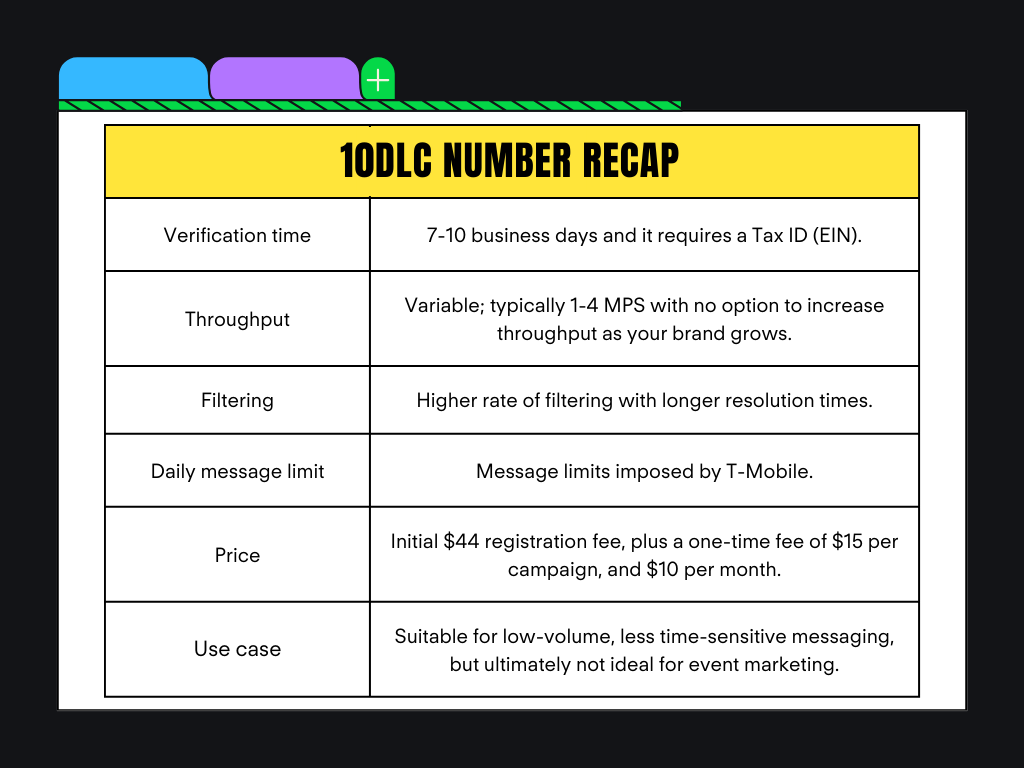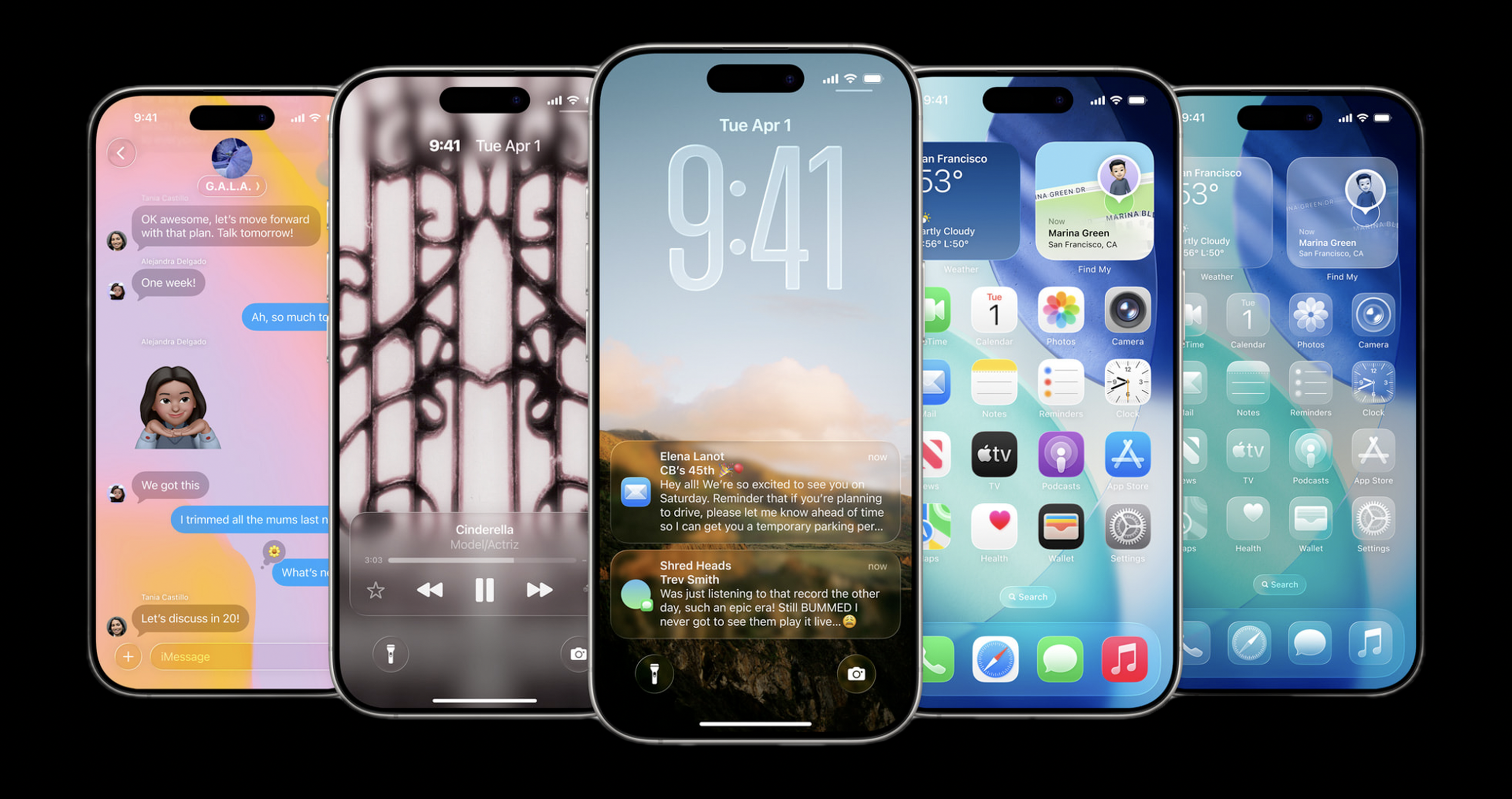SMS might be the new kid on the marketing block, but event promoters are quickly seeing its value. With high engagement rates, broad reach, and affordability, it’s no wonder SMS marketing generates $71 in revenue on average for every dollar spent.
But before you dive into your first campaign, there's an important choice to make: which SMS number type to use. It might seem like a small detail, but this decision is crucial to your campaigns’ success, affecting everything from message deliverability to fan engagement. While some may assume there’s only one default option, knowing that you have a choice can make all the difference in improving your results.
To make this decision easier, we'll break down the different number types, their pros and cons, and Hive’s recommended approach.
Overview of SMS number types
SMS numbers come in various forms, each serving a unique purpose. For text marketing, event promoters have three main options: toll-free numbers, short codes, and 10-digit long codes (10DLC). Understanding the differences between these types is key to making the most of SMS marketing for your events. But before we dive into number types, here are some key terms you’ll want to know to help you navigate the world of SMS marketing:
- MPS: Stands for ‘messages per second’, which represents the number of messages your SMS number can send per second.
- Filtering: A process conducted by cell phone carriers to check the content of SMS messages and "filter" messages they think are spam or don't comply with regulations.
- Campaign: The specific types of messages that are sent to your subscribers, such as promotions, alerts, or updates.
1. Toll-free numbers
Toll-free numbers are a versatile and cost-effective choice for SMS marketing, provided to all Hive clients at no extra cost. This makes them an appealing alternative to short codes and 10DLC, which often come with setup and registration fees.
These numbers are flexible enough to scale with your needs, whether you’re managing low- or high-volume messaging. Thanks to Hive’s custom agreements with service providers, verification is quick—typically within one business day, but Hive guarantees it won’t take longer than three. This speed is unique to Hive, unlike other providers, which often take longer and may come with additional fees.
Performance-wise, toll-free numbers offer a strong starting throughput of 3 MPS, and can be scaled past 100 MPS when needed for high-volume senders or extremely time-sensitive campaigns. Meanwhile, filtering is automatically detected and resolved by Hive’s service provider rather than being done at the carrier level. This means issues are handled faster than other SMS options. This makes toll-free numbers a reliable and efficient choice for event promoters who need a scalable and cost-effective SMS solution.
.png?width=686&height=515&name=TF%20numbers%20(1).png)
2. Short Codes
Short codes are designed for high-volume messaging with unmatched speed and reliability. These 5- to 6-digit numbers are easy for fans to remember and interact with, making them ideal for promotions, contests, and urgent campaigns.
What sets short codes apart is their superior throughput, starting at 100 MPS and easily scaling beyond that to handle even the most demanding campaigns. This high throughput means your messages are delivered with superior speed, making short codes an excellent choice for large-scale events or time-sensitive updates where quick engagement is crucial.
While the verification process for short codes is more involved than for toll-free numbers—typically taking 6 to 10 weeks due to carrier approvals—Hive has streamlined this to just 3 to 4 weeks, significantly cutting down the wait time. As a result of this thorough verification process, short codes come with minimal filtering to ensure a high level of deliverability and reliability for your messages.
While short codes come with higher setup and registration costs than toll-free numbers, their unmatched speed and capacity make them a standout option for event promoters. However, pricing can vary widely, typically ranging from hundreds to thousands of dollars per month. As a result, short codes are ideal for situations where the messaging volume is so high that 100+ MPS throughput is required, or when exceptionally fast message delivery is needed even with lower volumes.

3. 10-digit long code (10DLC)
10DLCs use local 10-digit phone numbers, giving your SMS marketing a localized touch. Designed for application-to-person (A2P) messaging, 10DLCs strike a balance between cost and functionality but come with specific limitations.
Verification for 10DLCs typically takes 7 to 10 business days, which is faster than the industry norm thanks to Hive’s streamlined process. However, each type of campaign you plan to send needs approval, and sending messages that stray from the registered content can result in increased filtering. Registering for 10DLCs also requires a Tax ID (EIN) and comes with the following additional costs:
- $44 for initial registration
- One-time fee of $15 per campaign type
- Plus an additional $10 per month
Throughput for 10DLC varies based on your brand’s trust score, which is assigned during verification. Most promoters and venues receive a low trust score, which results in a throughput of 1 to 4 MPS. Well-established brands (like those with a strong physical and online presence, over 10 years in business, and detailed privacy policies) are typically assigned a medium trust score, allowing for a throughput of around 40 MPS. However, very few brands achieve such high trust scores, and even then, the throughput remains lower than other SMS options.
While there’s an option to submit a one-time appeal to adjust your trust score, it’s a costly process and the decision is final. This means that once your 10DLC trust score is assigned, you cannot increase your number’s throughput as your brand or SMS needs grow over time.
10DLC phone numbers are also the only type that have daily message limits imposed by carriers. Using T-Mobile as an example, most standard 10DLC numbers with a low trust score are restricted to approximately 700 messages (3 segments per message) per day. Filtering is also more aggressive with 10DLCs, and issues take longer to resolve, which can be problematic for time-sensitive campaigns.
For most brands—especially those looking to grow—these constraints make 10DLC phone numbers a non-starter. These limitations can affect the scalability of your number and overall SMS marketing strategy, making it difficult to meet growing needs.

Why 10DLC is not ideal for event marketing
10DLC numbers often fall short for event marketing due to their lower throughput which can severely impact the timely delivery of messages. For example, sending 10,000 messages (with 3 segments per message) at a standard rate of 4 MPS would take more than two hours on a standard 10DLC number. In contrast, a toll-free number with a mid-range throughput of 50 MPS could send the same batch in just 10 minutes.
Another major limitation is the daily message limits imposed by carriers which can make large-scale or time-sensitive campaigns difficult to manage. This makes 10DLC the only SMS option with such strict daily volume restrictions, and these limits become a non-starter for brands looking to scale their event marketing.
The approval process for 10DLC adds another layer of complexity. Not only is it lengthy, but it's also prone to errors, especially for newer or smaller brands. Each campaign type must be registered separately, which can lead to unnecessary complications and a disconnect between the approved content and what you actually want to send.
Higher filtering rates with 10DLC also increase the risk of delays or message blocks, especially during time-sensitive campaigns like last-minute ticket sales. Unlike toll-free numbers and short codes, resolving filtering issues with 10DLC can take significantly longer, leading to missed opportunities and lower campaign success.
Lastly, for brands that unknowingly use 10DLC phone numbers, there’s a strong chance you will need to transition to a toll-free or short code number in the future, which can be both costly and time-consuming. In some cases, you may even have to rebuild your entire SMS subscriber list from scratch when starting over with a new number. These limitations make 10DLC a less viable option for event marketing, where scalability and speed are essential.
Hive's approach and recommendations
At Hive, our goal is to make your event marketing as smooth and effective as possible. Hive sends more SMS marketing messages for event promoters than any other platform, and we’ve partnered with several of the top service providers and carriers to create a system specifically tailored to the needs of event promoters. Unlike other SMS marketing platforms that cater to celebrities or local businesses, Hive’s approach is uniquely designed to meet the demands of event marketing.
Through our direct consultations with carriers, we’ve learned that the future of SMS marketing is further shifting away from mass, real-time messaging over 10DLC. Carriers are tightening restrictions on throughput, content, and volume for 10DLC, making it less viable for event promotions. Instead, toll-free numbers and short codes provide a more reliable and future-proof solution, ensuring your messages are delivered quickly, effectively, and without the hassle or cost of switching off 10DLC in the future.
For most event promoters, we recommend toll-free numbers because they offer high throughput, minimal filtering, and quick verification—all at no extra cost. These numbers provide the scalability and speed needed to reach your subscribers, whether you’re running low- or high-volume campaigns.
If you require even more speed and capacity, short codes are the way to go. Hive offers the best short code pricing in the industry, along with the fastest and smoothest registration process, making it the best choice for those needing top-tier messaging performance.
By focusing on toll-free and short code options, Hive helps you avoid the pitfalls of 10DLC and ensures your event marketing stays efficient, scalable, and aligned with the evolving landscape of SMS marketing.
Wrap up
Choosing the right SMS number type is essential for successful event marketing. Each option—toll-free, short codes, and 10DLC—offers unique advantages and challenges that can significantly impact your campaign's performance. By understanding these differences, you can make informed decisions that enhance message delivery, engage your audience, and avoid potential pitfalls. Ultimately, the right choice can make all the difference in ensuring your messages reach fans when it matters most.



